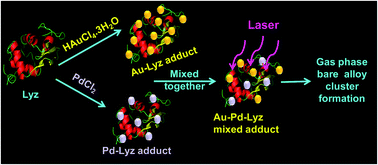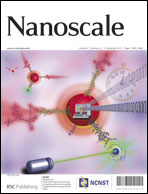Noble metal alloy clusters in the gas phase derived from protein templates: unusual recognition of palladium by gold†
Abstract
Matrix assisted laser desorption ionization of a mixture of gold and palladium adducts of the protein lysozyme (Lyz) produces naked alloy clusters of the type Au24Pd+ in the gas phase. While a lysozyme–Au adduct forms Au18+, Au25+, Au38+ and Au102+ ions in the gas phase, lysozyme–Pd alone does not form any analogous cluster. Addition of various transition metal ions (Ag+, Pt2+, Pd2+, Cu2+, Fe2+, Ni2+ and Cr3+) in the adducts contributes to drastic changes in the mass spectrum, but only palladium forms alloys in the gas phase. Besides alloy formation, palladium enhances the formation of specific single component clusters such as Au38+. While other metal ions like Cu2+ help forming Au25+ selectively, Fe2+ catalyzes the formation of Au25+ over all other clusters. Gas phase cluster formation occurs from protein adducts where Au is in the 1+ state while Pd is in the 2+ state. The creation of alloys in the gas phase is not affected whether a physical mixture of Au and Pd adducts or a Au and Pd co-adduct is used as the precursor. The formation of Au cores and AuPd alloy cores of the kind comparable to monolayer protected clusters implies that naked clusters themselves may be nucleated in solution.


 Please wait while we load your content...
Please wait while we load your content...